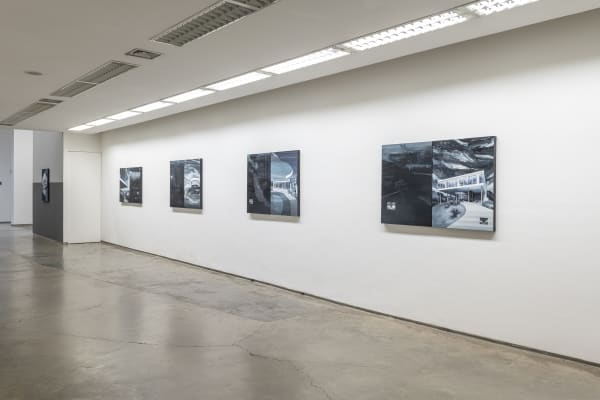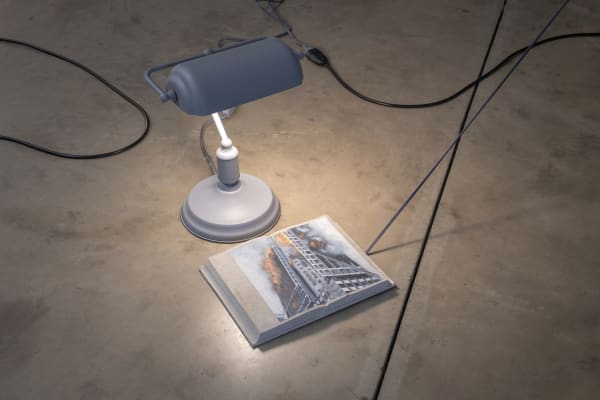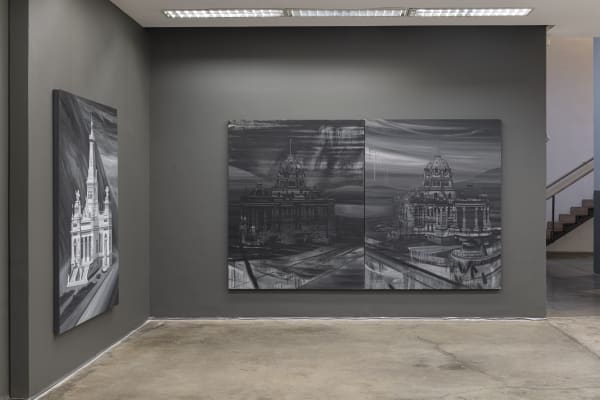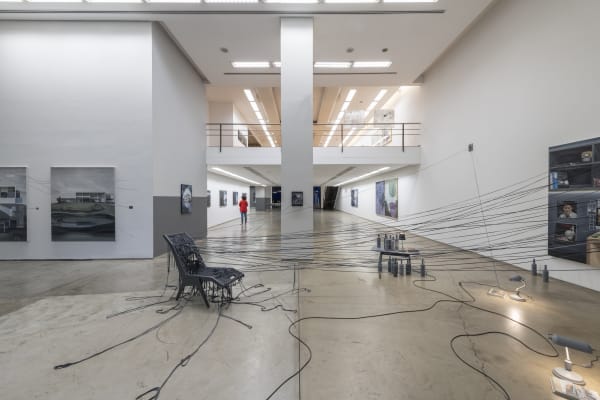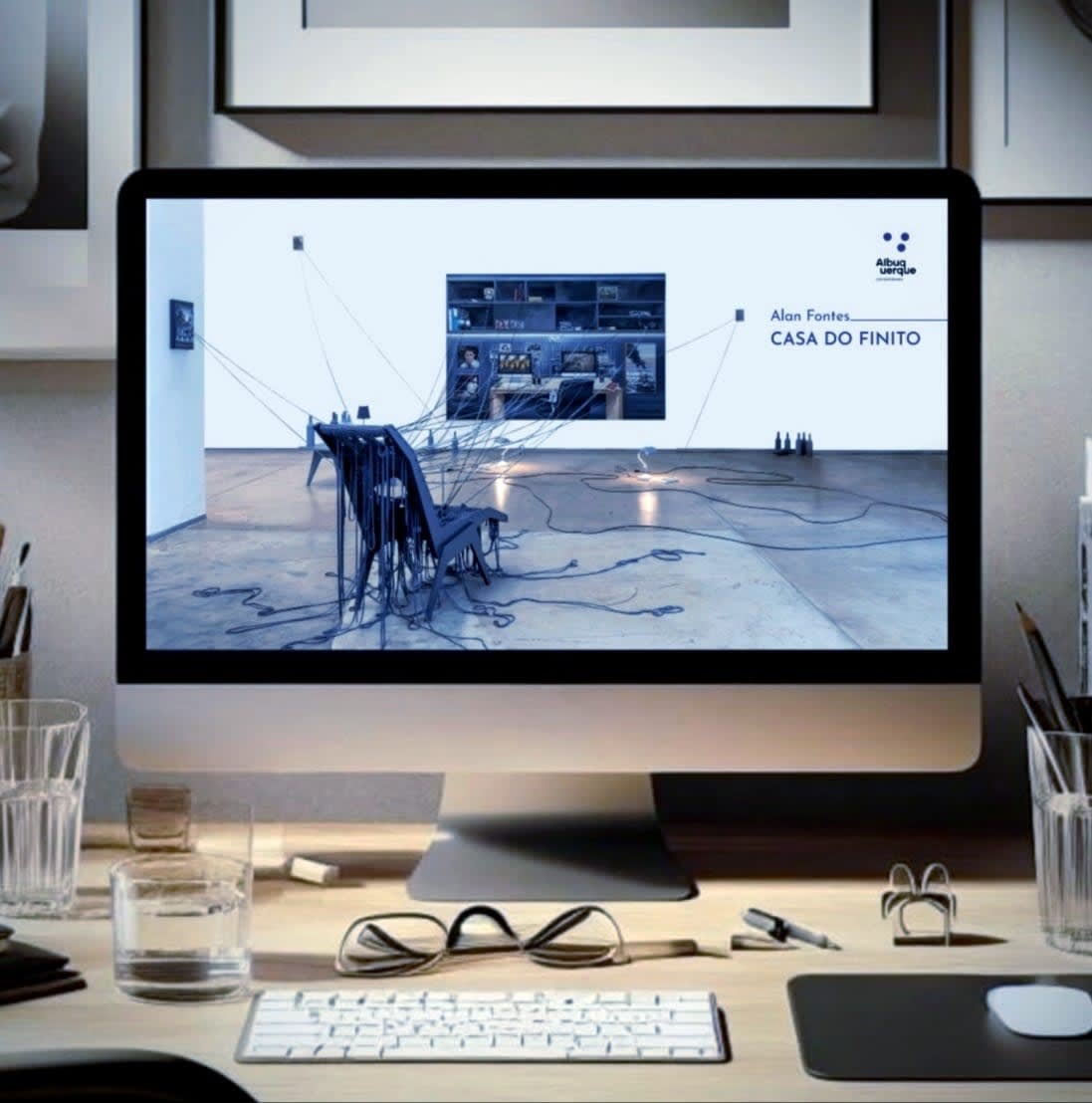Casa do Finito: Alan Fontes
Past exhibition
Works
Press
Publications
Press release
ALAN FONTES Casa do Finito, by Patricia Wagner
SP, July 20th, 2023
Casa do Finito, Alan Fontes' solo exhibition at Galeria Albuquerque Contemporânea, presents the artist's recent production in full accordance with the trajectory and singular grammar established by him over the last few years: the pictorial image and real space, the relationship between gray and a minimal and punctual chromatic palette, the distinction between public and private, what belongs to the individual and history. To this non-linear set of interests, there is an investigation into the nature of the image and its ability to affect everything that surrounds it, in the potential and indeterminate limit that it establishes with the observer.
Casa do Finito is also the name of the installation that names the exhibition. It is a representation of a work environment: an office - or, as the Covid-19 pandemic has consecrated to calling it, home-office - typical of a middle-class home, whose furniture was made for the architectural dimensions in which it is installed.
Even if there aren't enough books or objects to fill the large bookshelf, it's there, with empty spaces filled with a collection of images that aren't casual. In front of the canvas, a lounger tied to it by threads expands the viewer's perception beyond the field of pictorial representation, creating a contrast between images of different natures. By incorporating elements of the world into his work (in a procedure that alludes to what Robert Rauschenberg had done in the 50s, with the Combine paintings), Fontes seems to discuss the limits and freedom of representation, emphasizing the indeterminate place in which the materiality of the lounger would be located.
In the organization of the canvas, the shelf is, at the same time, figure and background for a personal collection of images that present themselves as signs or traces of a presence-absence. Books, photos, objects and newspaper clippings are indicators of the lack of someone whose cell phone still has the screen on and who perhaps hasn't realized that a bottle is about to fall to the floor. As signs, such elements act in a related sense in the relationship they establish with each other, or as a circuit of ideas, preferences and personal tastes. Within the scope of such connections, the three bottles of coca-cola, in reference to the work of Cildo Meireles – Inserções em Circuitos Ideológicas, from 1970 -, function as a fragment that illuminates the whole. They reinforce the eminently political character of the structure of meanings woven around the various elements on the shelf, thus combining an imaginary of doubts and uncertainties.
As is recurrent in the artist's production, there is no human figure in his canvases. Perhaps because it is not possible in his use of gray in his paintings. Fontes decided to incorporate this color as a skin in his works, as a form of erasure, to nullify the real and make the painting strong in the face of the material and ordinary reality of objects. In art history, the use of gray as a film that sits over paint dates back to the Middle Ages. The monochromatic painting technique in shades of gray is called grisalha and in the artist's use of it there is no neutrality, but a latency that sustains an immemorial, mythical or fictional time. A time that cannot be reduced to chronos, to its linearity, but a time that is outside of history. Within the scope of this temporal suspension, promoted by grisalha, the encounter (or confrontation) of the LP, the cell phone, images of war around the world, a disruptive tornado and diachrony - represented by the work Perfect Lovers, by Felix Gonzalez-Torres - they are consistent with a ruinous temporality, which imprints on the canvas a feeling of permanent melancholy.
In the Livro de Pedra (Book of Stone) series, the relationships between painting and object, image and matter gain new thickness. A set of images created from photographic archives of urban landscapes finds its support in the concrete sculptural object, whose shape suggests that of a book. The multiplicity of images, constructed by the artist in the books on display, highlights the public dimension of architecture in compositions that are sometimes monumental, sometimes prosaic. Architecture, as a work of art whose perception by the masses occurs through use, differs from individualized contemplation, from a private relationship between the observer and the work, which has always given it the vocation of being the bearer of a collective memory. The book, an object that represents the apex of individual contemplation (an aspect that art, in its varied expressive forms, no longer privileges), is currently experiencing its moment of greatest threat and contempt. By spreading the dust of time, Fontes petrifies the internal relationships that the images could suggest to highlight the external and ambivalent associations between the book object and collective memory.
If, through the previous series, the artist discusses the links between individual memory and collective memory, their relationships, porosities and conflicts, in the Finito Series he adds an investigation into the expressive nature of the image itself in a construction that mobilizes notions of memory, assembly and dialectics. In the four diptychs, monuments and buildings on one side are confronted with abstract paintings with expressive brushstrokes on the other, which dominate almost the entire canvas. In some of them, like a tiny grafted fragment, the representation of a tornado signals the disorder of the contemporary world. Faced in a dialectical confrontation, the paintings reveal the collapse of a rationalist and utopian project of ordering life, with which modernity flirted at different times.
As a theme, architecture is, for Alan Fontes, a carrier of individual and collective stories. An astute narrator, who gives visibility to aesthetic, political, social or economic projects. In the domestic sphere, it is a privileged source for understanding a symbolic repertoire of ways of living. But it is in the tension built between the public and the private that, in A Casa do Finito, the “art of space” occupies, by metonymy, the task of being the double of time. And it is through this space-time relationship that the artist invites the observer to the sensitive task of seeing in a state of alert. Only under this condition can images protect their memories and the possibility of always being questioned.
Patricia Wagner


